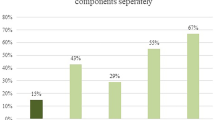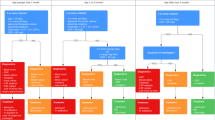Abstract
Justification
India, home to almost 1.5 billion people, is in need of a country-specific, evidence-based, consensus approach for the emergency department (ED) evaluation and management of the febrile child.
Process
We held two consensus meetings, performed an exhaustive literature review, and held ongoing web-based discussions to arrive at a formal consensus on the proposed evaluation and management algorithm. The first meeting was held in Delhi in October 2015, under the auspices of Pediatric Emergency Medicine (PEM) Section of Academic College of Emergency Experts in India (ACEE-INDIA); and the second meeting was conducted at Pune during Emergency Medical Pediatrics and Recent Trends (EMPART 2016) in March 2016. The second meeting was followed with futher e-mail-based discussions to arrive at a formal consensus on the proposed algorithm.
Objective
To develop an algorithmic approach for the evaluation and management of the febrile child that can be easily applied in the context of emergency care and modified based on local epidemiology and practice standards.
Recommendations
We created an algorithm that can assist the clinician in the evaluation and management of the febrile child presenting to the ED, contextualized to health care in India. This guideline includes the following key components: triage and the timely assessment; evaluation; and patient disposition from the ED. We urge the development and creation of a robust data repository of minimal standard data elements. This would provide a systematic measurement of the care processes and patient outcomes, and a better understanding of various etiologies of febrile illnesses in India; both of which can be used to further modify the proposed approach and algorithm.
Similar content being viewed by others
References
Balmuth F, Henretig FM, Alpern ER. Fever. In: RG Bachur & KN Shaw (eds.) Fleisher & Ludwig’s Textbook of Pediatric Emergency Medicine, 7th edition. Lippincott Williams and Wilkins. Philadelphia, PA, USA. 2016. p. 176–85.
ACEP Clinical Policies Committee and Clinical Policies Subcommittee on Pediatric Fever. Clinical Policy for Children Younger than Three Years Presenting to the Emergency Department with Fever. Ann Emerg Med. 2003;42:530–45.
Seow VK, Lin AC, Lin IY, Chen CC, Chen KC, Wang TL, et al. Comparing different patterns for managing febrile children in the ED between emergency and pediatric physicians: impact on patient outcome. Am J Emerg Med. 2007;25:1004–8.
Phillips B, Selwood K, Lane SM, Skinner R, Gibson F, Chisholm JC; United Kingdom Children’s Cancer Study Group. Variation in policies for the management of febrile neutropenia in United Kingdom Children’s Cancer Study Group centres. Arch Dis Child.2007;92:495–8.
Aronson PL, Thurm C, Williams DJ, Nigrovic LE, Alpern ER, Tieder JS, et al.; Febrile Young Infant Research Collaborative. Association of clinical practice guidelines with emergency department management of febrile infants =56 days of age. J Hosp Med. 2015;10:358–65.
Harper MB. Update on the management of the febrile infant. Clin Pediatr Emerg Med. 2004;5:5–12.
Abrahamsen SK, Haugen CN, Rupali P, Mathai D, Langeland N, Eide GE, et al. Fever in the tropics: Aetiology and case-fatality-A prospective observational study in a tertiary care hospital in South India. BMC Infect Dis. 2013;13:355.
Singhi S, Rungta N. Tropical fever: Management Guidelines. Ind J Crit Care Medicine. 2014;18:62–9.
Jatana SK. Pediatric emergencies in office practice—an overview. Med J Armed Forces India. 2012; 68:4–5.
Mahajan P, Batra P, Shah B, Saha A, Galwankar S, Aggrawal P, et al. The 2015 Academic College of Emergency Experts in India’s INDO-US Joint Working Group white paper on establishing an academic department and training pediatric emergency medicine specialists in India. Indian Pediatr. 2015;52:1061–71.
Niven DJ, Gaudet JE, Laupland KB, Mrklas KJ, Roberts DJ, Stelfox HT. Accuracy of peripheral thermometers for estimating temperature: a systematic review and metaanalysis. Ann Intern Med. 2015;163:768–77.
Brown PJ, Christmas BF, Ford RP. Taking an infant’s temperature: Axillary or rectal thermometer? N Z Med J. 1992;105:309–11.
Batra P, Goyal S. Comparison of rectal, axillary, tympanic, and temporal artery thermometry in the pediatric emergency room. Pediatr Emerg Care. 2013;29:63–6.
Batra P, Saha A, Faridi MM. Thermometry in children. J Emerg Trauma Shock. 2012;5:246–9.
Pocketbook of Hospital Care for Children: Guidelines for the Management of Common Childhood Illnesses–Second Edition. WHO 2013. Available from: http://apps.who.int/iris/bitstream/10665/81170/1/9789241548373_eng.pdf. Accessed August 25, 2016.
WHO Emergency Triage and Treatment (ETAT). Manual for Participants. WHO Press. Geneva, Switzerland. 2005. Available from: http://apps.who.int/iris/bitstream/10665/43386/1/9241546875_eng.pdf. Accessed August 25, 2016.
Seiger N, Maconochie I, Oostenbrink R, Moll HA. Validity of different pediatric early warning scores in the emergency department. Pediatrics. 2013;132:e841–50.
Holtzclaw B J. Managing fever and febrile symptoms in HIV: Evidence-based approaches. J Assoc Nurses AIDS Care. 2013;24: S86–102.
Jhaveri R, Byington CL, Klein JO, Shapiro ED. Management of the nontoxic-appearing acutely febrile child: a 21st century approach. J Pediatr. 2011;159:181–5.
Brown L, Shaw T, Moynihan JA, Denmark TK, Mody A, Wittlake WA. Investigation of afebrile neonates with a history of fever. Canad J Emerg Med. 2004;6:343–8.
Ishimine P. Fever without source in children 0 to 36 months of age. Pediatr Clin North Am. 2006;53:167–94.
Care Process Model. Emergency Management of the wellappearing febrile infant age 1-90 days. Intermountain Health Care. May 2013. Available from: https://intermountain healthcare.org/ext/Dcmnt%3Fncid%3D520441555. Accessed August 25, 2016.
Bressan S, Andreola B, Cattelan F, Zangardi T, Perilongo G, Da Dalt L. Predicting severe bacterial infections in wellappearing febrile neonates: laboratory markers accuracy and duration of fever. Pediatr Infect Dis J. 2010;29:227–32.
Markic J, Kovacevic T, Krzelj V, Bosnjak N, Sapunar A. Lab-score is a valuable predictor of serious bacterial infection in infants admitted to hospital. Wien Klin Wochenschr. 2015;127:942–7.
Nijman RG, Moll HA, Smit FJ, Gervaix A, Weerkamp F, Vergouwe Y, et al. C-reactive protein, procalcitonin and the lab-score for detecting serious bacterial infections in febrile children at the emergency department: a prospective observational study. Pediatr Infect Dis J. 2014;33:e273–9.
Mahajan P, Grzybowski M, Chen X, Kannikeswaran N, Stanley R, Singal B, et al. Procalcitonin as a marker of serious bacterial infections in febrile children younger than 3 years old. Acad Emerg Med. 2014;21:171–9.
Author information
Authors and Affiliations
Consortia
Corresponding author
Rights and permissions
About this article
Cite this article
Mahajan, P., Batra, P., Thakur, N. et al. Consensus guidelines on evaluation and management of the febrile child presenting to the emergency department in India. Indian Pediatr 54, 652–660 (2017). https://doi.org/10.1007/s13312-017-1129-8
Received:
Revised:
Accepted:
Published:
Issue Date:
DOI: https://doi.org/10.1007/s13312-017-1129-8




